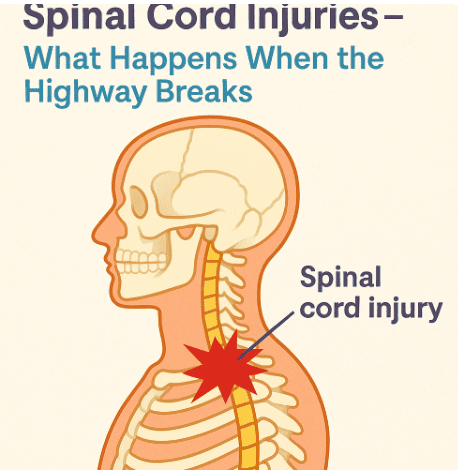
In Lesson 1, we learned that the spinal cord is the main highway carrying signals between the brain and body. In Lesson 2, we discovered how the spinal cord can act instantly through reflexes, and in Lesson 3, we saw how the brain and spinal cord are protected by meninges, cerebrospinal fluid, and the spine.
But even with all those protections, sometimes accidents still happen. The spinal cord can be injured, and when that happens, the consequences can be life-changing. Today, we will carefully explore what happens when the “highway of signals” is damaged.
🚧 Step 1: Why Spinal Cord Injuries Are So Serious
If you scratch your skin, it heals. If you break a bone, doctors can fix it with a cast, and the bone grows back. But the spinal cord is different.
The spinal cord is made of neurons—nerve cells that do not easily regrow once damaged. If the “wires” of the spinal cord are cut or crushed, the signals cannot travel up or down. That means:
-
The brain cannot receive messages from the body.
-
The brain cannot send commands to the body.
The result? Parts of the body may lose movement (paralysis) and/or feeling (loss of sensation).
🛣️ Step 2: Where the Injury Happens Matters
The spinal cord is like a highway with many exits. If the highway is blocked at a certain point, everything below that point is cut off.
-
Injury at the neck (cervical region) → Can affect arms, legs, and even breathing. This may cause quadriplegia (loss of movement in all four limbs).
-
Injury in the chest (thoracic region) → Usually affects the legs but not the arms. This is called paraplegia.
-
Injury in the lower back (lumbar or sacral region) → May affect the legs, bladder, or bowel control, but the upper body works normally.
So, the higher up the injury, the more body functions are lost.
⚡ Step 3: Types of Spinal Cord Injuries
There are two main types of injuries:
-
Complete Injury
-
The spinal cord is fully damaged at that point.
-
No signals pass through.
-
Result: total loss of sensation and movement below the injury.
-
-
Incomplete Injury
-
Only part of the spinal cord is damaged.
-
Some signals can still pass through.
-
Result: partial movement or sensation remains.
-
Doctors test which type of injury has happened by checking reflexes, sensations, and muscle strength.
🚨 Step 4: Causes of Spinal Cord Injuries
Spinal cord injuries can happen in many ways:
-
Car accidents 🚗: The most common cause.
-
Falls 🤕: Especially in older people.
-
Sports injuries ⚽🤸: Diving, gymnastics, football, or extreme sports.
-
Violence 🔫: Gunshots or knife wounds.
-
Diseases 🦠: Tumors, infections, or multiple sclerosis can also damage the spinal cord.
🌱 Step 5: What Happens After an Injury
When the spinal cord is injured, two things happen:
-
Immediate Shock
-
The body goes into “spinal shock.”
-
Reflexes stop, muscles go limp, and sensations disappear.
-
-
Long-Term Effects
-
Reflexes may return but are often exaggerated.
-
Muscles may become stiff (spasticity).
-
Loss of bladder and bowel control may occur.
-
Chronic pain can develop.
-
Doctors and scientists are working hard to find ways to heal the spinal cord, but recovery is very difficult.
🦾 Step 6: Living with a Spinal Cord Injury
Although the spinal cord cannot easily repair itself, people with injuries can still live full lives with the help of:
-
Wheelchairs and mobility aids.
-
Physical therapy to strengthen remaining muscles.
-
Occupational therapy to relearn everyday tasks.
-
Assistive technology like voice-controlled computers or robotic exoskeletons.
Many people with spinal cord injuries become athletes, artists, or leaders, showing that while the body may face limits, the mind can remain strong.
🔬 Step 7: The Hope of Science
For many years, doctors thought spinal cord injuries could never be repaired. But today, exciting research is happening:
-
Stem cell therapy: Scientists are trying to grow new nerve cells.
-
Nerve grafts: Using healthy nerves from other parts of the body to reconnect damaged areas.
-
Electrical stimulation: Implanting tiny devices that “zap” the spinal cord, helping paralyzed people move again.
-
Brain-computer interfaces: Technology that lets the brain control computers or robotic limbs directly, bypassing the injured spinal cord.
While full cures are not here yet, progress is being made every year.
📝 Recap of Lesson 4
-
Spinal cord injuries are very serious because neurons do not regrow easily.
-
The higher the injury, the more body functions are lost.
-
Injuries can be complete (no signals pass) or incomplete (some signals pass).
-
Common causes include car accidents, falls, sports, violence, and diseases.
-
People with injuries face challenges but can live fulfilling lives with therapy and technology.
-
New research in stem cells, nerve grafts, and brain-computer interfaces offers hope for the future.